Combined Effects of the ENSO and the QBO on the Ozone Valley over the Tibetan Plateau
Abstract
1. Introduction
2. Data and Methods
2.1. Data
2.2. Methodology
3. Combined Effects of the ENSO and QBO on the Ozone Valley over the TP
3.1. Division of the ENSO and QBO
3.2. Responses of the Ozone Valley over the TP in the following Summer to the ENSO and QBO
4. Mechanistic Analysis
4.1. Dynamic Reasons
4.2. Thermodynamic Causes
5. Conclusions
Author Contributions
Funding
Data Availability Statement
Acknowledgments
Conflicts of Interest
References
- Bian, J.; Li, D.; Bai, Z.; Li, Q.; Lyu, D.; Zhou, X. Transport of Asian surface pollutants to the global stratosphere from the Tibetan Plateau region during the Asian summer monsoon. Natl. Sci. Rev. 2020, 7, 516–533. [Google Scholar] [CrossRef]
- Xia, Y.; Huang, Y.; Hu, Y. On the climate impacts of upper tropospheric and lower stratospheric ozone. J. Geophys. Res. Atmos. 2018, 123, 730–739. [Google Scholar] [CrossRef]
- Wang, Y.; Wang, H.; Wang, W. A Stratospheric intrusion-influenced ozone pollution episode associated with an intense horizontal-trough event. Atmosphere 2020, 11, 164. [Google Scholar] [CrossRef]
- Crutzen, P.J. The influence of nitrogen oxides on the atmospheric ozone content. Q. J. R. Meteorol. Soc. 1970, 96, 320–325. [Google Scholar] [CrossRef]
- Molina, M.J.; Rowland, F.S. Stratospheric sink for chlorofluoromethanes: Chlorine atom-catalysed destruction of ozone. Nature 1974, 249, 810–812. [Google Scholar] [CrossRef]
- Manney, G.L.; Santee, M.L.; Rex, M.; Livesey, N.J.; Pitts, M.C.; Veefkind, P.; Nash, E.R.; Wohltmann, I.; Lehmann, R.; Froidevaux, L. Unprecedented Arctic ozone loss in 2011. Nature 2011, 478, 469–475. [Google Scholar] [CrossRef]
- Zhang, X.; Zhou, J.; Göttsche, F.M.; Zhan, W.; Liu, S.; Cao, R. A method based on temporal component decomposition for estimating 1-km all-weather land surface temperature by merging satellite thermal infrared and passive microwave observations. IEEE Trans. Geosci. Remote Sens. 2019, 57, 4670–4691. [Google Scholar] [CrossRef]
- Zhang, J.; Sheng, Z.; Ma, Y.; He, Y.; Zuo, X.; He, M. Analysis of the positive Arctic oscillation index event and its influence in the winter and spring of 2019/2020. Front. Earth Sci. 2021, 8, 580601. [Google Scholar] [CrossRef]
- He, Y.; Zhu, X.; Sheng, Z.; Ge, W.; Zhao, X.; He, M. Atmospheric disturbance characteristics in the lower-middle stratosphere inferred from observations by the Round-Trip Intelligent Sounding System (RTISS) in China. Adv. Atmos. Sci. 2022, 39, 131–144. [Google Scholar] [CrossRef]
- Qin, Z.; Sheng, Z.; He, Y.; Feng, Y. Case Analysis of turbulence from high-resolution sounding data in Northwest China. Front. Environ. Sci. 2022, 10. [Google Scholar] [CrossRef]
- Xie, F.; Tian, W.; Chipperfield, M.P. Radiative effect of ozone change on stratosphere-troposphere exchange. J. Geophys. Res. Atmos. 2008, 113, D00B09. [Google Scholar] [CrossRef]
- Guo, D.; Su, Y.; Shi, C.; Xu, J.; Powell, A.M. Double core of ozone valley over the Tibetan Plateau and its possible mechanisms. J. Atmos. Sol.-Terr. Phys. 2015, 130, 127–131. [Google Scholar] [CrossRef]
- Chang, S.; Shi, C.; Guo, D.; Xu, J. Attribution of the principal components of the summertime ozone valley in the upper troposphere and lower stratosphere. Front. Earth Sci. 2021, 8, 721. [Google Scholar] [CrossRef]
- Ren, R.; Hu, J. An emerging precursor signal in the stratosphere in recent decades for the Indian summer monsoon onset. Geophys. Res. Lett. 2014, 41, 7391–7396. [Google Scholar] [CrossRef]
- Zhang, J.; Tian, W.; Xie, F.; Tian, H.; Luo, J.; Zhang, J.; Liu, W.; Dhomse, S. Climate warming and decreasing total column ozone over the Tibetan Plateau during winter and spring. Tellus Ser. B Chem. Phys. Meteorol. 2014, 66, 23415. [Google Scholar] [CrossRef]
- Baldwin, M.P.; Gray, L.J.; Dunkerton, T.J.; Hamilton, K.; Haynes, P.H.; Randel, W.J.; Holton, J.R.; Alexander, M.J.; Hirota, I.; Horinouchi, T.; et al. The quasi-biennial oscillation. Rev. Geophys. 2001, 39, 179–229. [Google Scholar] [CrossRef]
- Ineson, S.; Scaife, A.A. The role of the stratosphere in the European climate response to El Niño. Nat. Geosci. 2009, 2, 32–36. [Google Scholar] [CrossRef]
- Chang, S.; Shao, M.; Shi, C.; Xu, H. Intercomparing the response of tropospheric and stratospheric temperature to two types of El Niño Onset. Adv. Meteorol. 2017, 2017, 6414368. [Google Scholar] [CrossRef]
- Xie, F.; Li, J.; Tian, W.; Zhang, J.; Shu, J. The impacts of two types of El Niño on global ozone variations in the last three decades. Adv. Atmos. Sci. 2014, 31, 1113–1126. [Google Scholar] [CrossRef]
- Randel, W.J.; Garcia, R.R.; Calvo, N.; Marsh, D. ENSO influence on zonal mean temperature and ozone in the tropical lower stratosphere. Geophys. Res. Lett. 2009, 36, L1582. [Google Scholar] [CrossRef]
- Cagnazzo, C.; Manzini, E.; Calvo, N.; Douglass, A.R.; Akiyoshi, H.; Bekki, S.; Chipperfield, M.; Dameris, M.; Deushi, M.; Fischer, A.; et al. Northern winter stratospheric temperature and ozone responses to ENSO inferred from an ensemble of Chemistry Climate Models. Atmos. Chem. Phys. 2009, 9, 8935–8948. [Google Scholar] [CrossRef]
- Iza, M.; Calvo, N.; Manzini, E. The Stratospheric Pathway of La Niña. J. Clim. 2016, 29, 8899–8914. [Google Scholar] [CrossRef]
- Huang, R.; Zhang, R.; Zhang, Q. The 1997/ 98 ENSO cycle and its impact on summer climate anomalies in East Asia. Adv. Atmos. Sci. 2000, 17, 348–362. [Google Scholar]
- Wang, B.; Wu, R.; Fu, X. Pacific–East Asian Teleconnection: How Does ENSO Affect East Asian Climate? J. Clim. 2000, 13, 1517–1536. [Google Scholar] [CrossRef]
- Du, Y.; Xie, S.; Huang, G.; Hu, K. Role of air–sea interaction in the long persistence of El Niño–Induced North Indian Ocean warming. J. Clim. 2009, 22, 2023–2038. [Google Scholar] [CrossRef]
- Annamalai, H.; Liu, P.; Xie, S. Southwest Indian Ocean SST variability: Its local effect and remote influence on Asian monsoons. J. Clim. 2005, 18, 4150–4167. [Google Scholar] [CrossRef]
- Ding, Y. Analysis of the process and mechanisms of genesis and development for 2014–2016 mega El Niño event. Trans. Atmos. Sci. 2016, 39, 722–734. [Google Scholar]
- Qian, D.; Guan, Z. Different features of super and regular El Niño events and their impacts on the variation of the West Pacific Subtropical High. Acta Meteorol. Sin. 2018, 76, 394–407. [Google Scholar]
- Randel, W.J.; Thompson, A.M. Interannual variability and trends in tropical ozone derived from SAGE II satellite data and SHADOZ ozonesondes. J. Geophys. Res. Atmos. 2011, 116, D07303. [Google Scholar] [CrossRef]
- Reed, R.J. A tentative model of the 26-month oscillation in tropical latitudes. Q. J. R. Meteorol. Soc. 1964, 90, 441–466. [Google Scholar] [CrossRef]
- Naoe, H.; Deushi, M.; Yoshida, K.; Shibata, K. Future changes in the ozone Quasi-Biennial Oscillation with increasing GHGs and ozone recovery in CCMI simulations. J. Clim. 2017, 30, 6977–6997. [Google Scholar] [CrossRef]
- Zhang, J.; Zhang, C.; Zhang, K.; Xu, M.; Duan, J.; Chipperfield, M.P.; Feng, W.; Zhao, S.; Xie, F. The role of chemical processes in the quasi-biennial oscillation (QBO) signal in stratospheric ozone. Atmos. Environ. 2021, 244, 117906. [Google Scholar] [CrossRef]
- Gabis, I.P. Quasi-biennial oscillation of the equatorial total ozone: A seasonal dependence and forecast for 2019–2021. J. Atmos. Sol.-Terr. Phys. 2020, 207, 105353. [Google Scholar] [CrossRef]
- Zou, H.; Ji, C.; Zhou, L. QBO signal in total ozone over Tibet. Adv. Atmos. Sci. 2000, 17, 562–568. [Google Scholar]
- Eleftheratos, K.; Zerefos, C.S.; Balis, D.S.; Koukouli, M.E.; Kapsomenakis, J.; Loyola, D.G.; Valks, P.; Coldewey-Egbers, M.; Lerot, C.; Frith, S.M.; et al. The use of QBO, ENSO, and NAO perturbations in the evaluation of GOME-2 MetOp A total ozone measurements. Atmos. Meas. Tech. 2019, 12, 987–1011. [Google Scholar] [CrossRef]
- Xie, F.; Li, J.; Tian, W.; Zhang, J.; Sun, C. The relative impacts of El Niño Modoki, canonical El Niño, and QBO on tropical ozone changes since the 1980s. Environ. Res. Lett. 2014, 9, 064020. [Google Scholar] [CrossRef]
- Lee, S.; Shelow, D.M.; Thompson, A.M.; Miller, S.K. QBO and ENSO variability in temperature and ozone from SHADOZ, 1998–2005. J. Geophys. Res. Atmos. 2010, 115, D18105. [Google Scholar] [CrossRef]
- Yuan, S.; Xu, J.; Chan, J.; Chiu, L.; Pan, Y. Resonance effect in interaction between South Asian summer monsoon and ENSO during 1958–2018. J. Trop. Meteorol. 2020, 26, 137–149. [Google Scholar]
- Ribera, P.; Peña-Ortiz, C.; Garcia-Herrera, R.; Gallego, D.; Gimeno, L.; Hernández, E. Detection of the secondary meridional circulation associated with the quasi-biennial oscillation. J. Geophys. Res. Atmos. 2004, 109, D18112. [Google Scholar] [CrossRef]
- Bian, J.; Yan, R.; Chen, H.; Lü, D.; Massie, S.T. Formation of the summertime ozone valley over the Tibetan Plateau: The Asian summer monsoon and air column variations. Adv. Atmos. Sci. 2011, 28, 1318–1325. [Google Scholar] [CrossRef]
- Ando, H.; Imamura, T.; Tellmann, S.; Pätzold, M.; Häusler, B.; Sugimoto, N.; Takagi, M.; Sagawa, H.; Limaye, S.; Matsuda, Y.; et al. Thermal structure of the Venusian atmosphere from the sub-cloud region to the mesosphere as observed by radio occultation. Sci. Rep. 2020, 10, 3448. [Google Scholar] [CrossRef] [PubMed]
- Zhang, Q.; Qian, Y.; Zhang, X. Interannual and interdecadal variations of the South Asia High. Sci. Atmos. Sin. 2000, 24, 67–78. [Google Scholar]

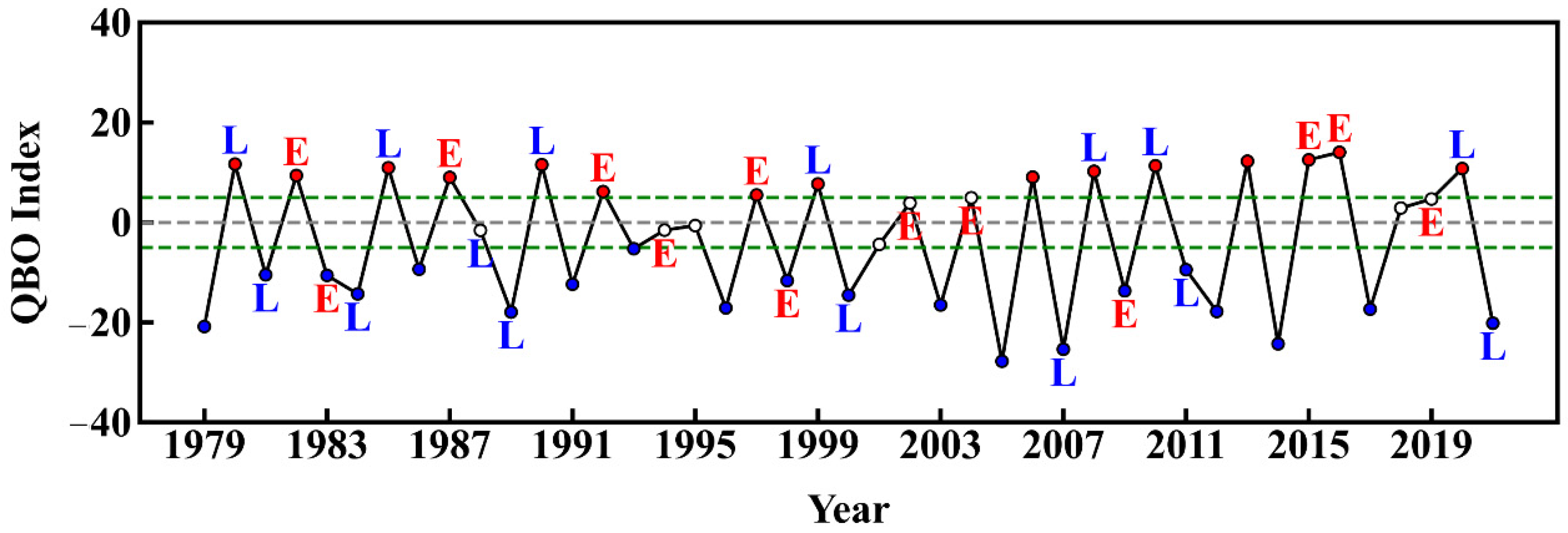
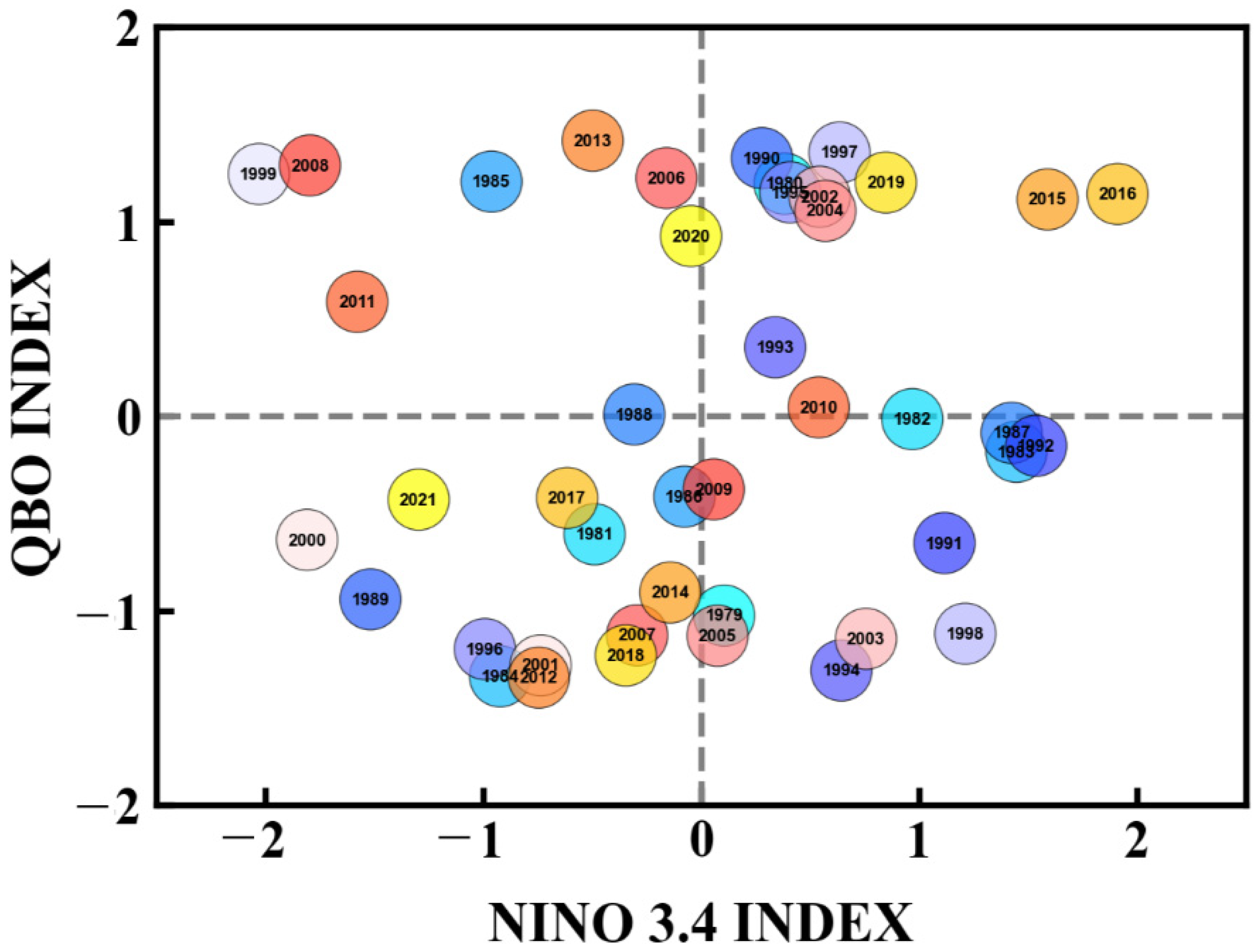
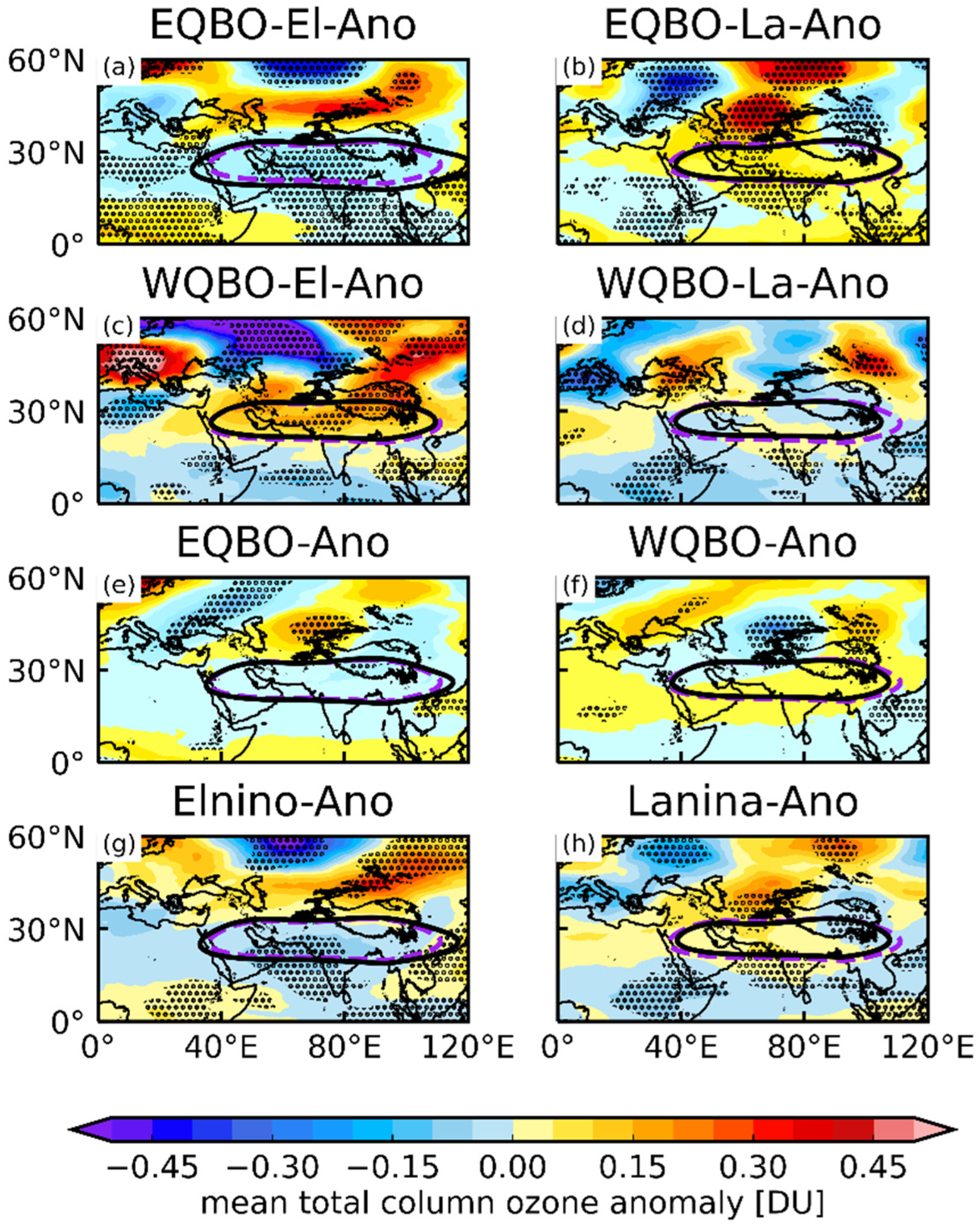
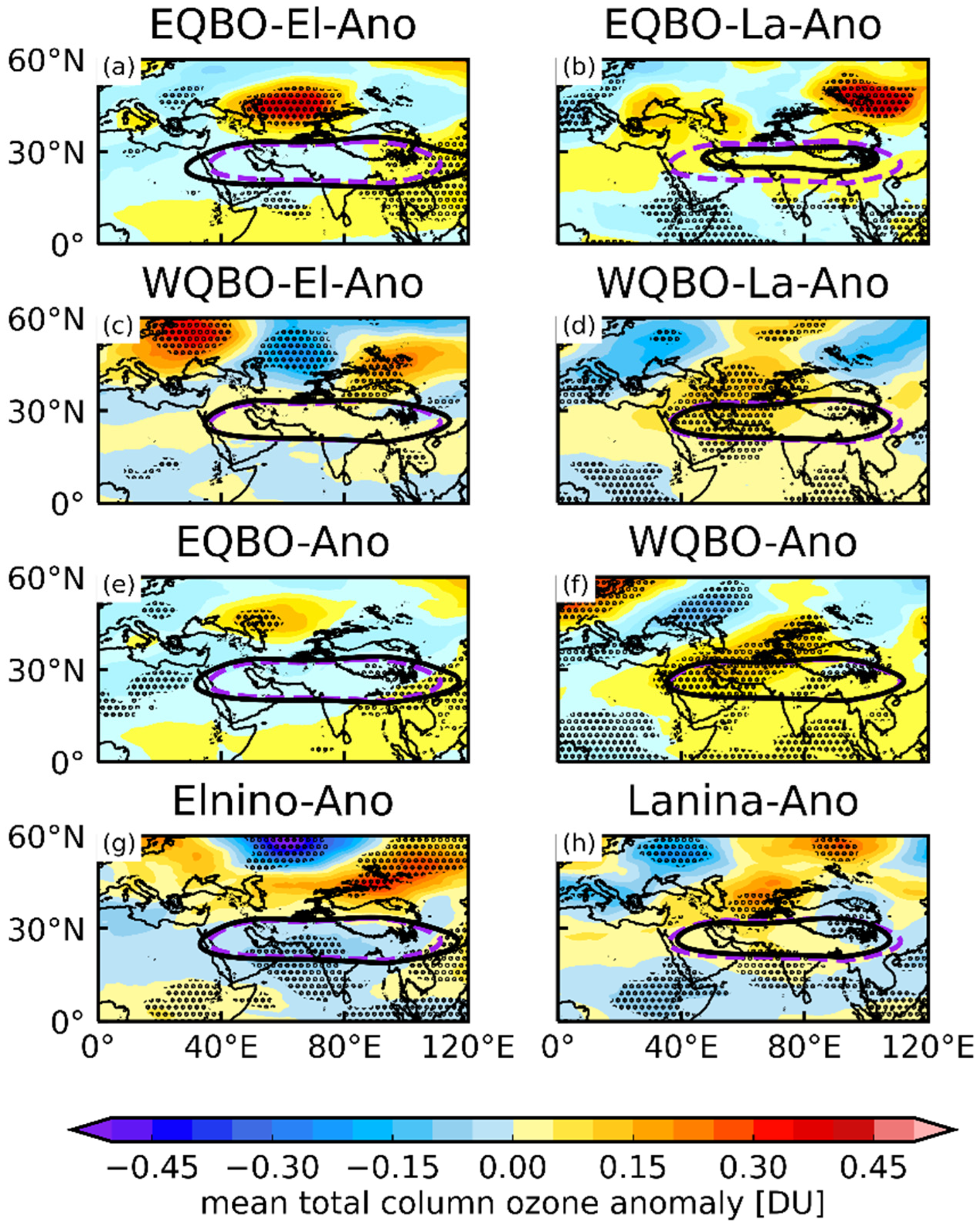
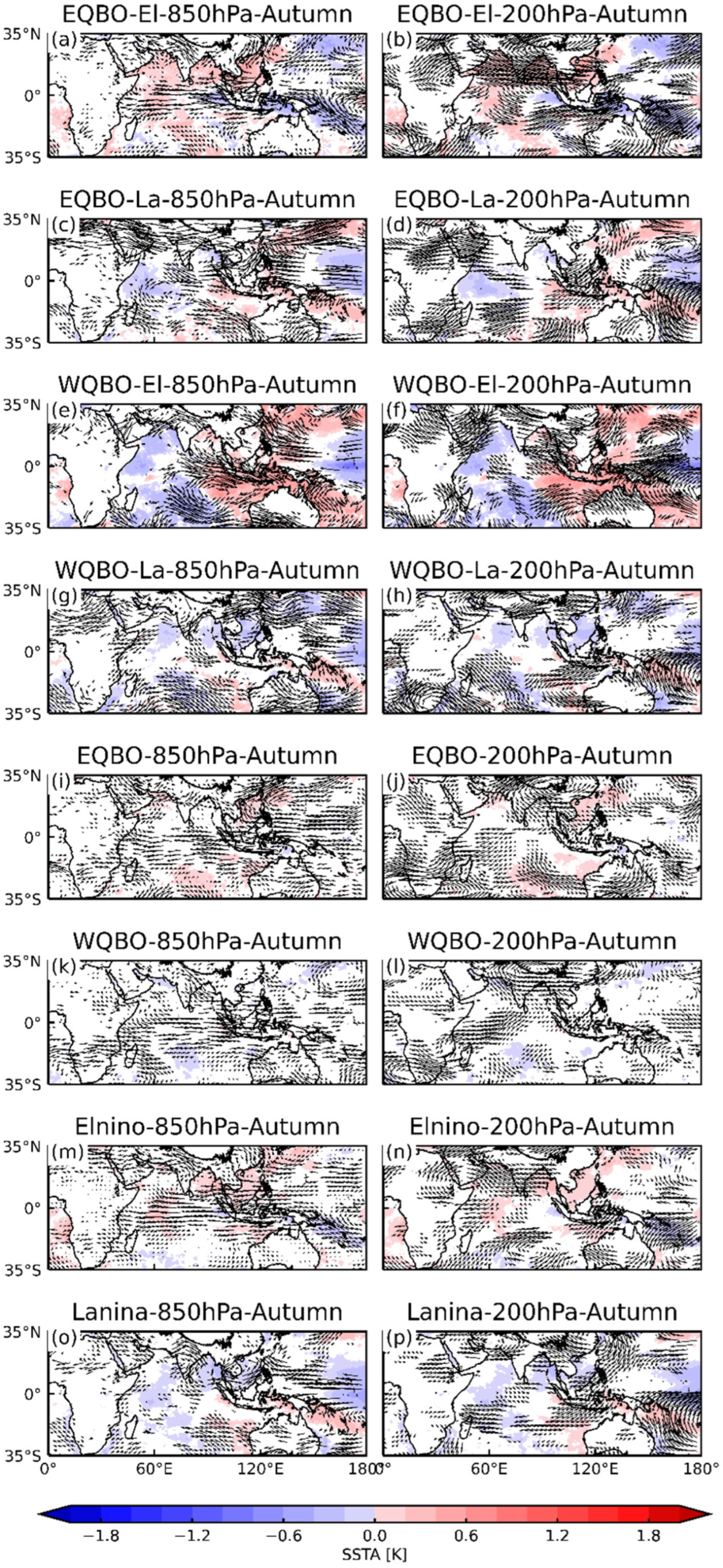
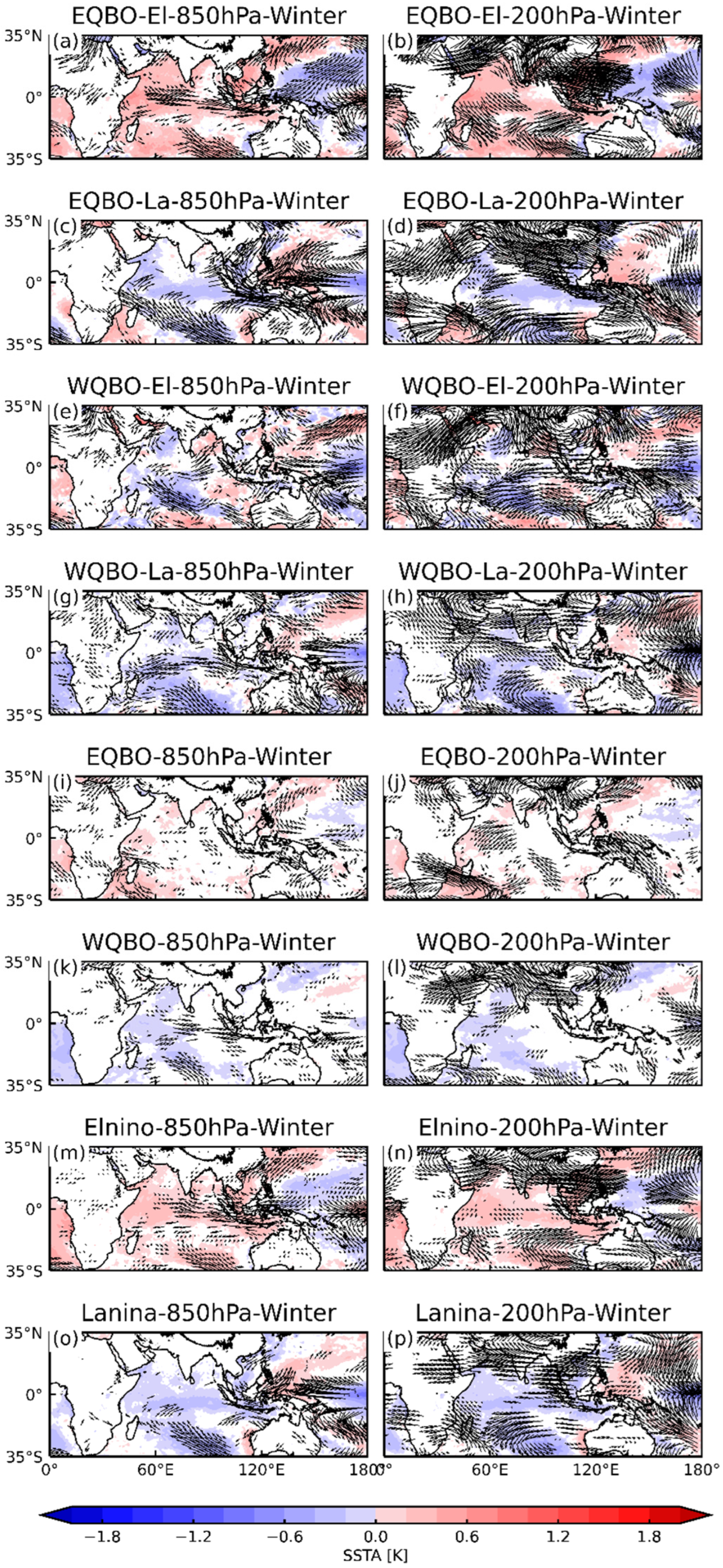
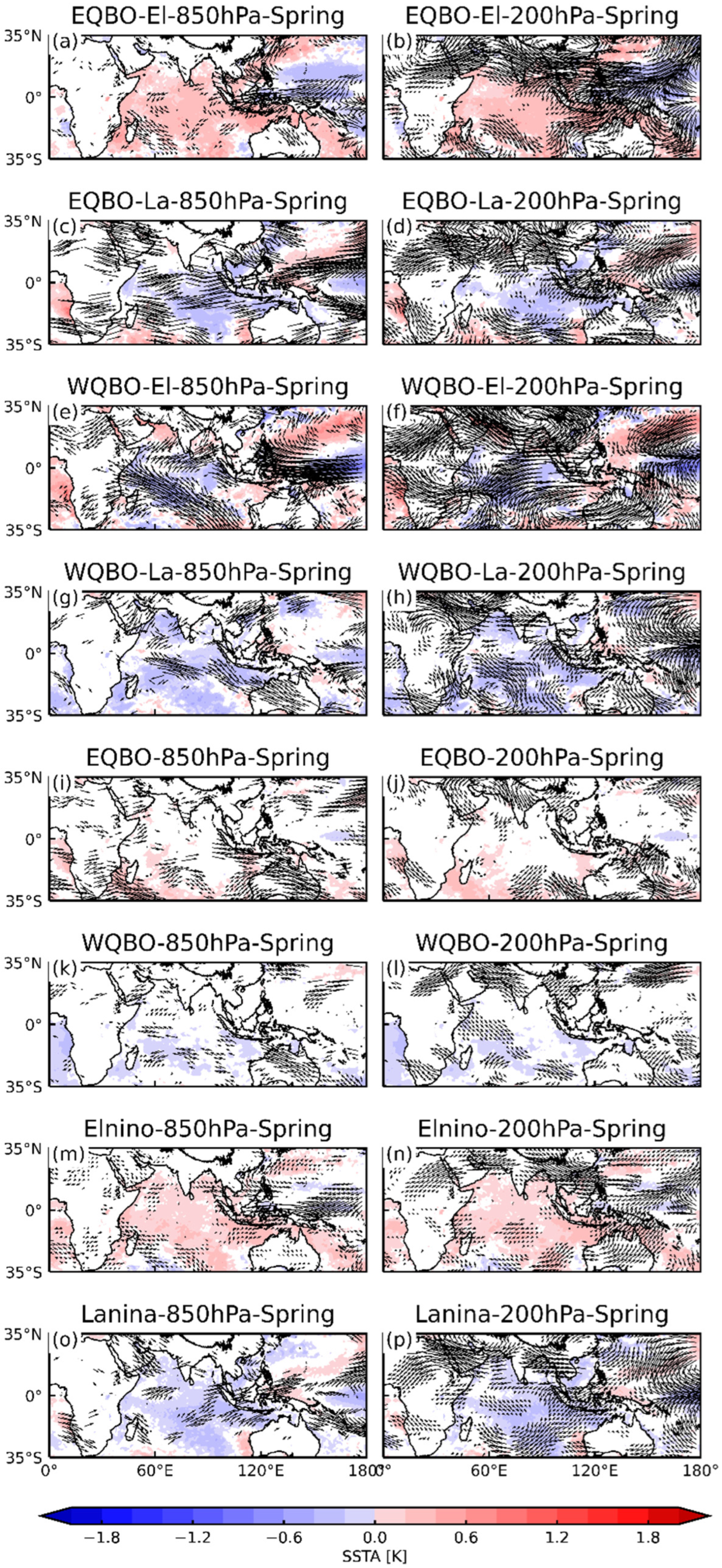
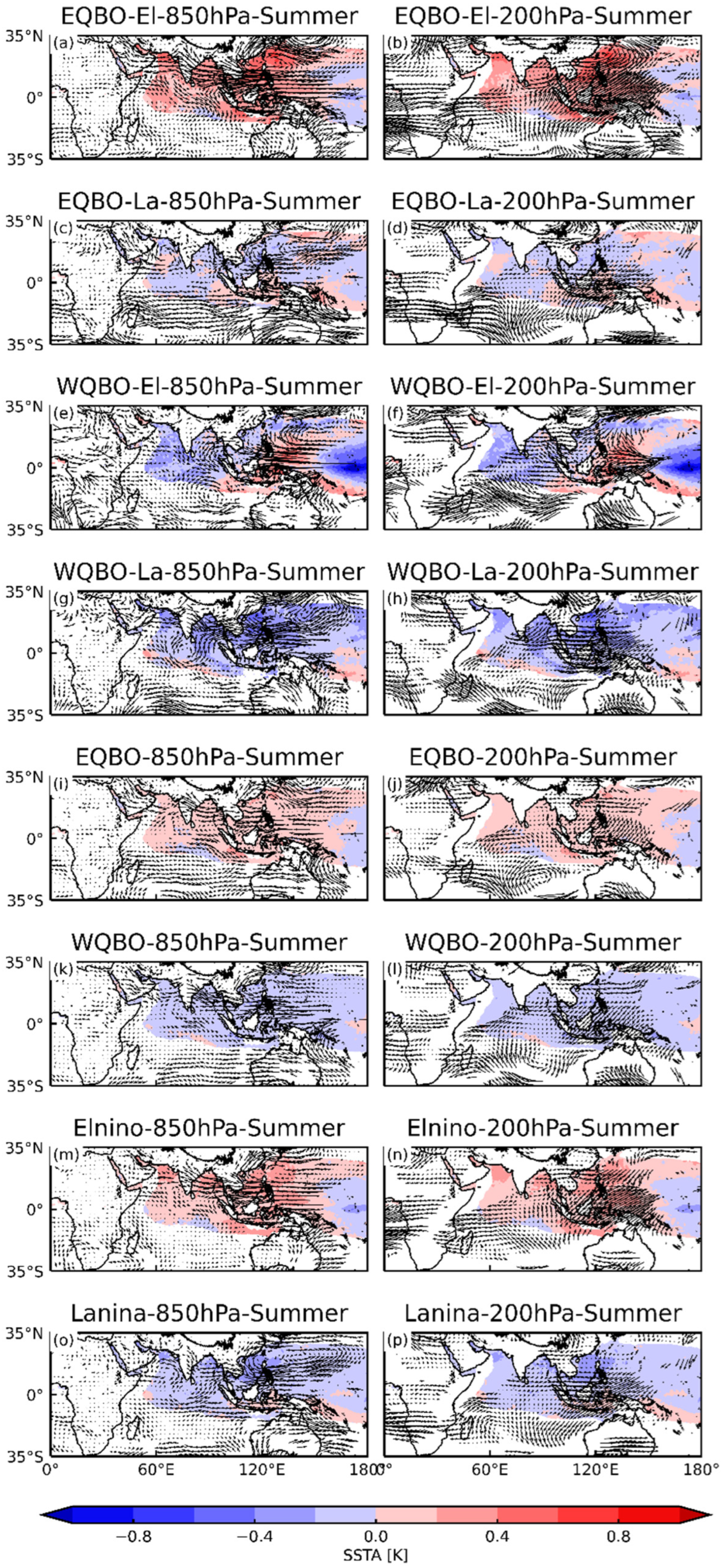
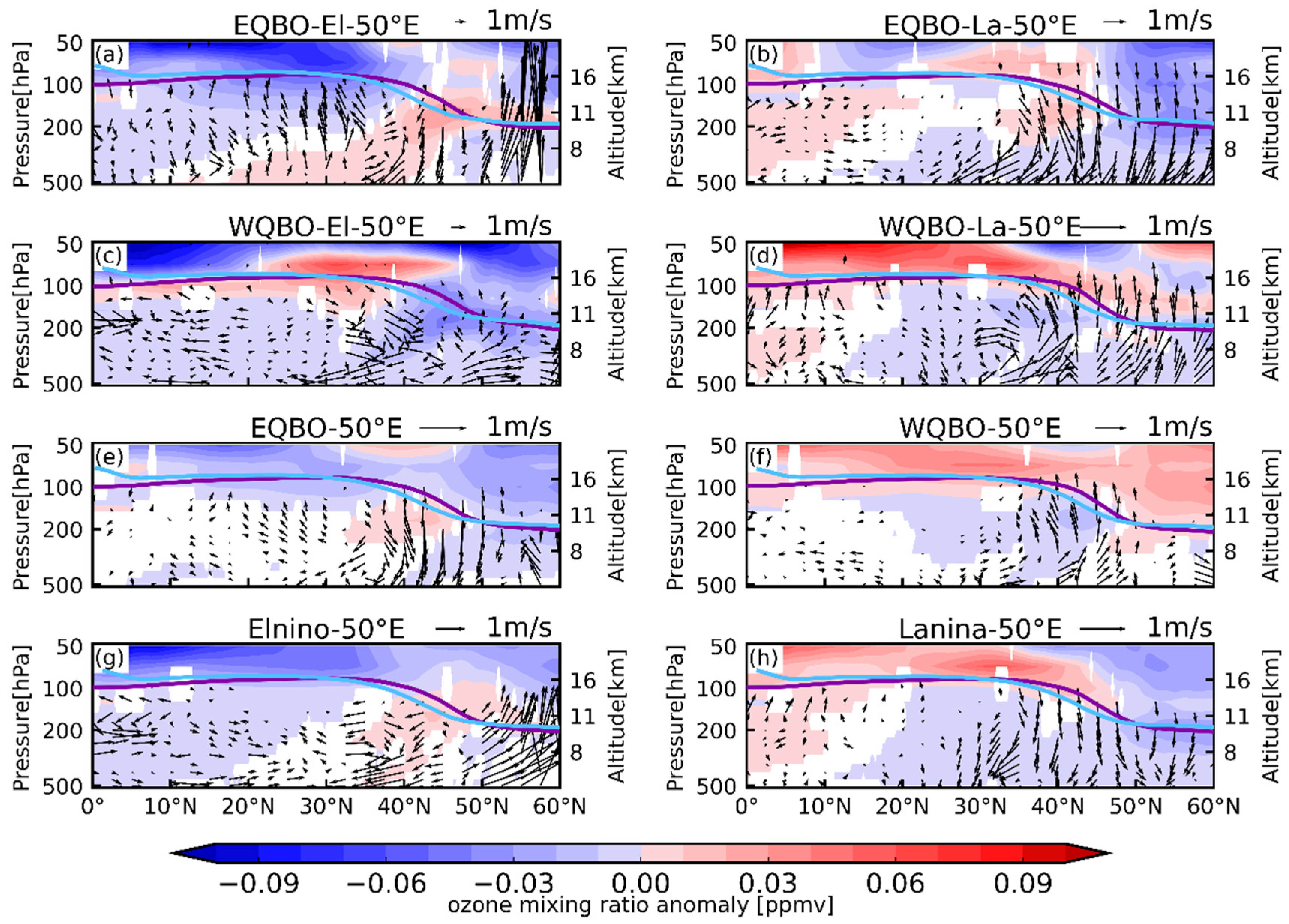
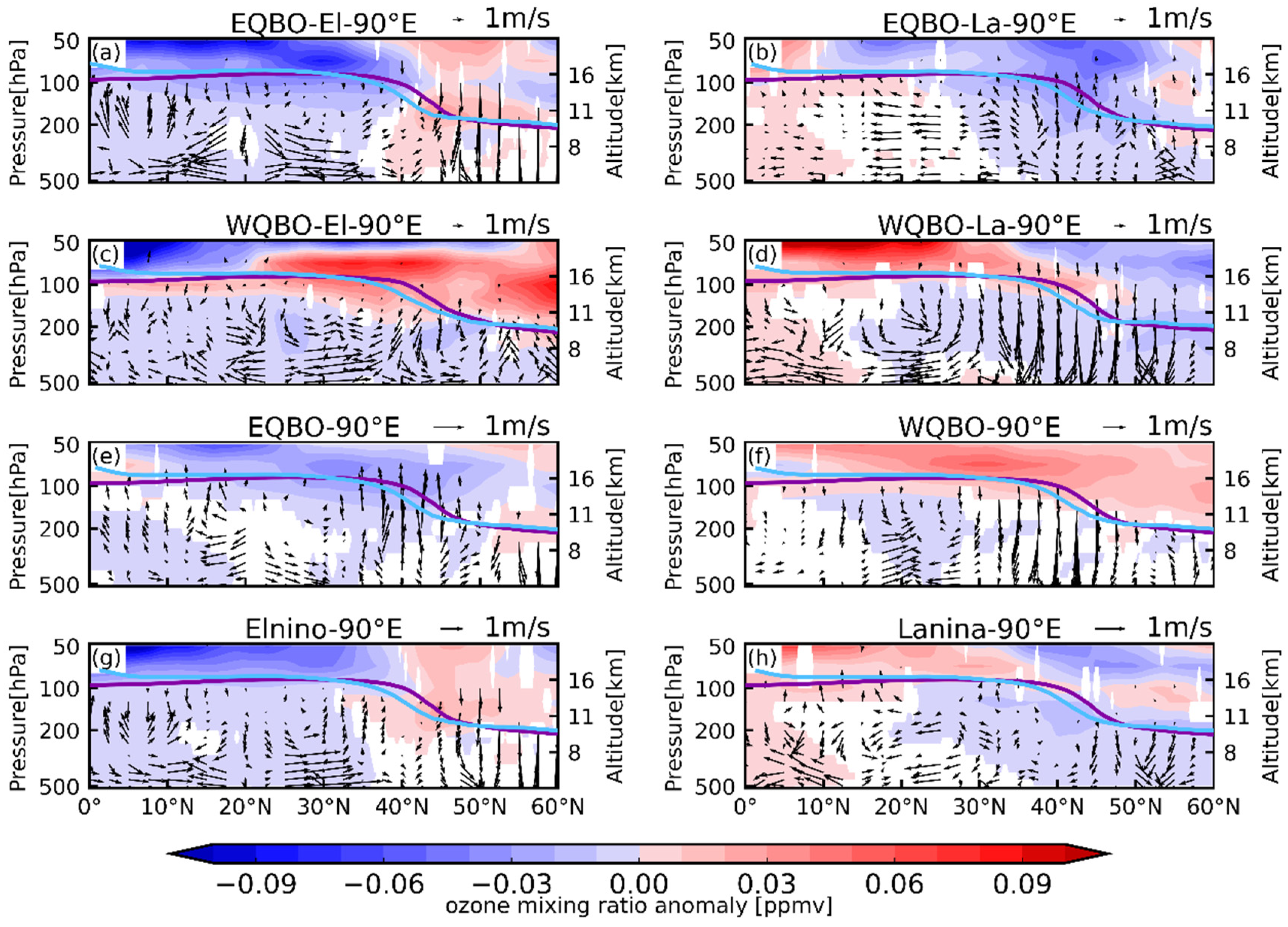
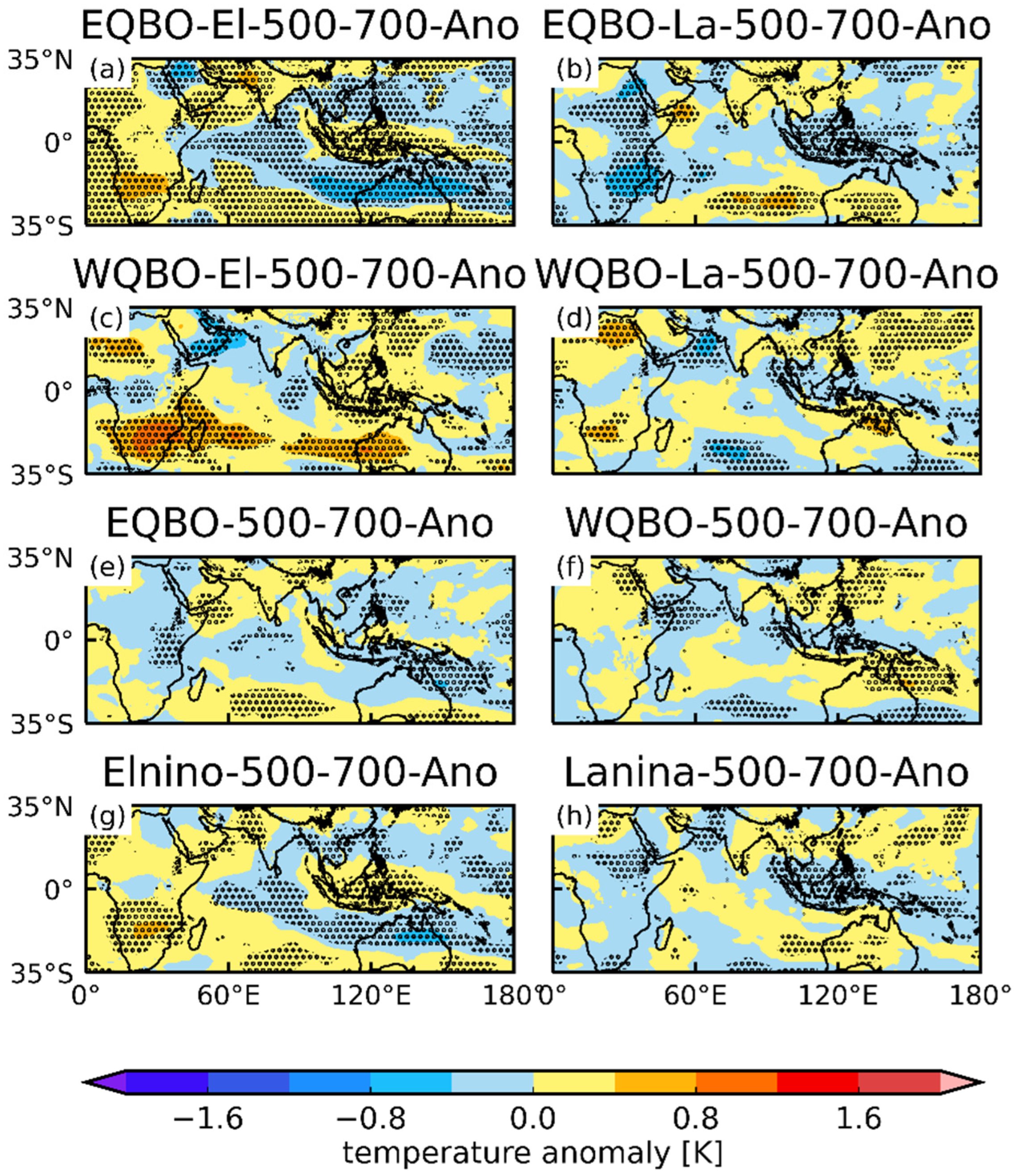
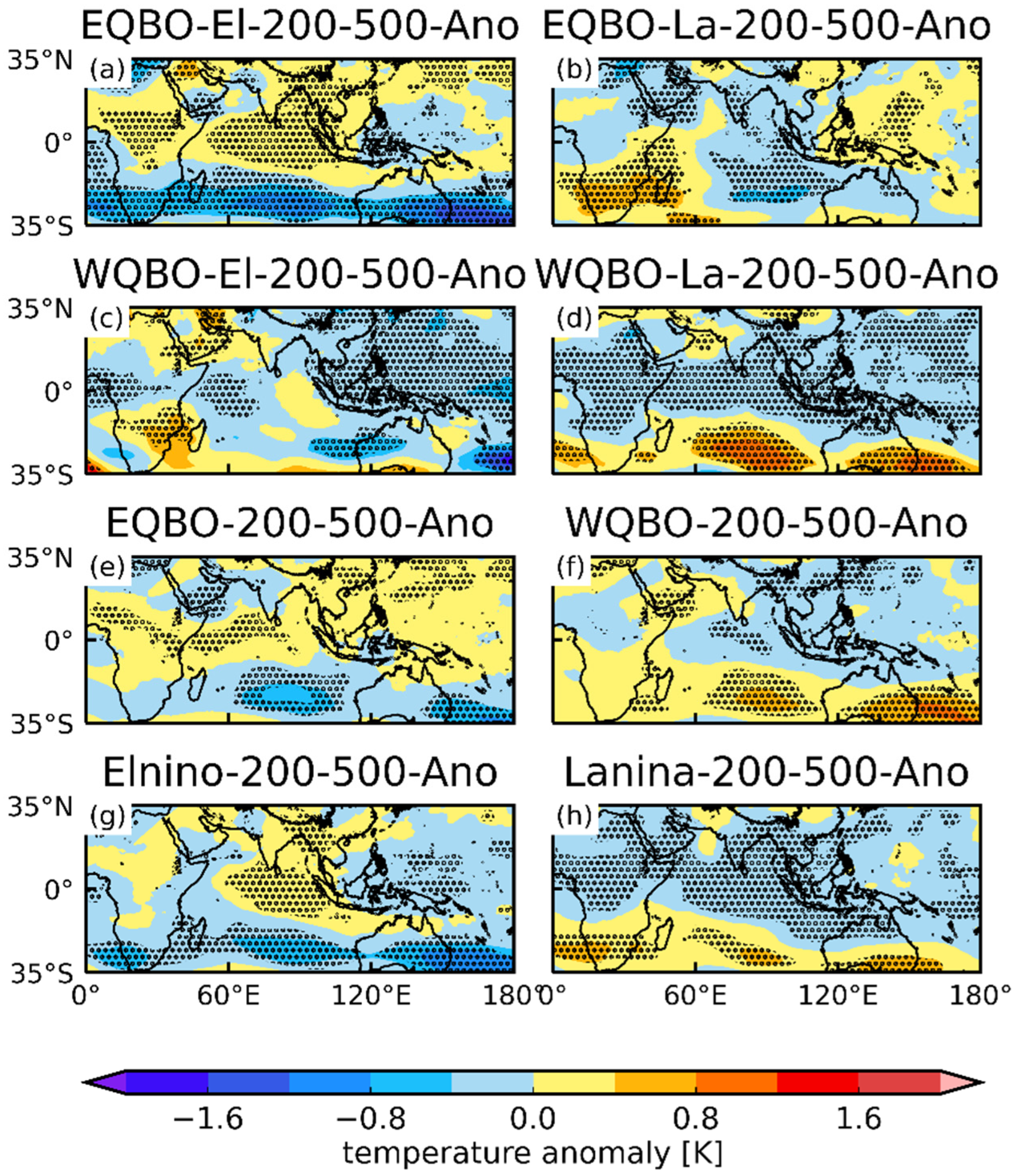
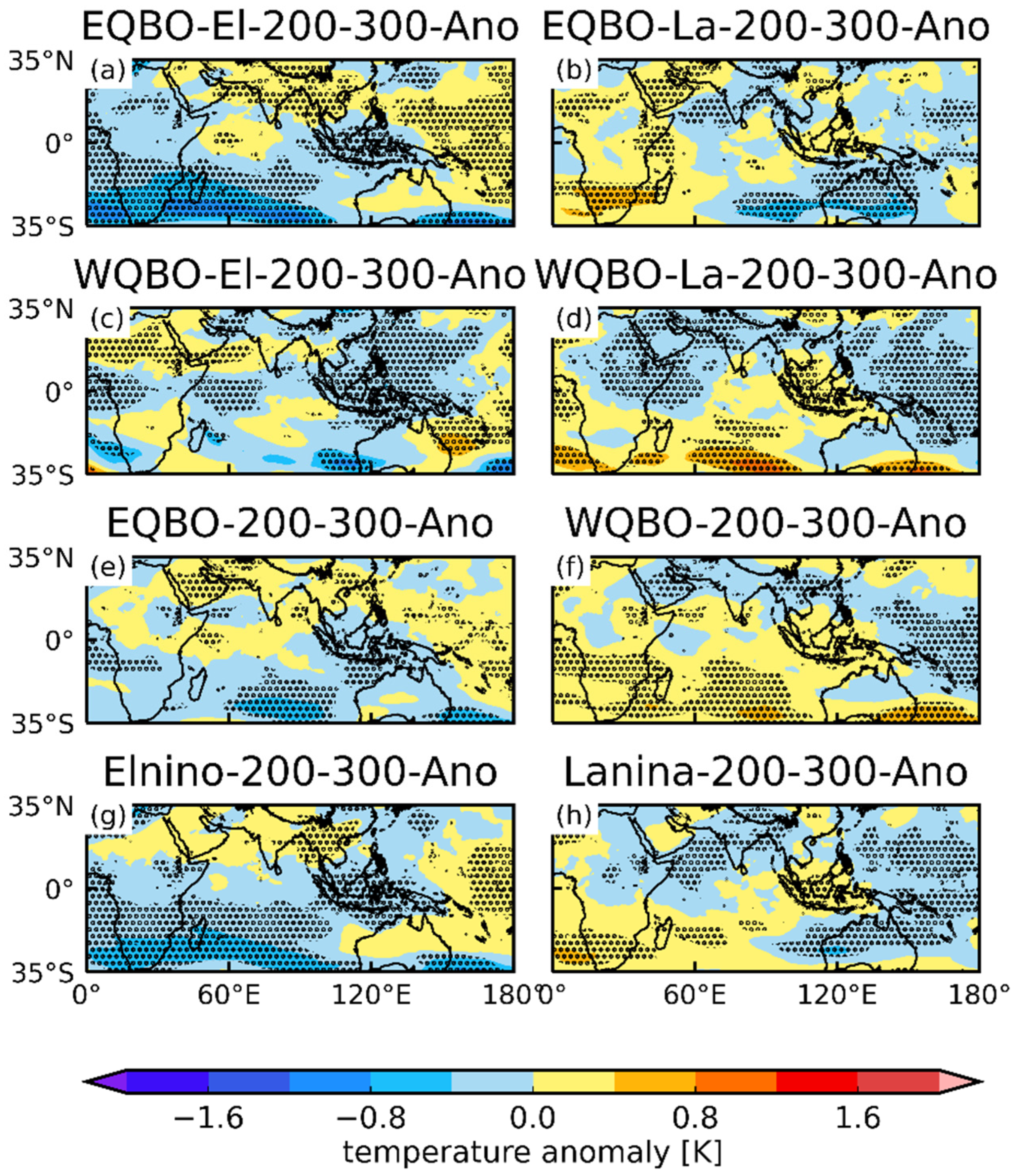
| Patterns | Years |
|---|---|
| El Niño | 1982, 1983, 1987, 1992, 1994, 1997, 1998, 2002, 2004, 2009, 2015, 2016, 2019 |
| La Niña | 1980, 1981, 1984, 1985, 1988, 1989, 1990, 1999, 2000, 2007, 2008, 2010, 2011, 2020, 2021 |
| East phase | 1980, 1982, 1985, 1987, 1990, 1992, 1997, 1999, 2006, 2008, 2010, 2013, 2015, 2016, 2020 |
| West phase | 1979, 1981, 1983, 1984, 1986, 1989, 1991, 1993, 1996, 1998, 2000, 2003, 2005, 2007, 2009, 2011, 2012, 2014, 2017, 2021 |
| East phase + El Niño | 1982, 1987, 1992, 1997, 2015, 2016 |
| East phase + La Niña | 1980, 1985, 1990, 1999, 2008, 2010, 2020 |
| West phase + El Niño | 1983, 1998, 2009 |
| West phase + La Niña | 1981, 1984, 1989, 2000, 2007, 2011, 2021 |
| Patterns | Years |
|---|---|
| El Niño | 1983, 1984, 1988, 1993, 1995, 1998, 1999, 2003, 2005, 2010, 2016, 2017, 2020 |
| La Niña | 1981, 1982, 1985, 1986, 1989, 1990, 1991, 2000, 2001, 2008, 2009, 2011, 2012, 2021 |
| East phase | 1981, 1983, 1986, 1988, 1991, 1993, 1998, 2000, 2007, 2009, 2011, 2014, 2016, 2017, 2021 |
| West phase | 1980, 1982, 1984, 1985, 1987, 1990, 1992, 1994, 1997, 1999, 2001, 2004, 2006, 2008, 2010, 2012, 2013, 2015, 2018 |
| East phase + El Niño | 1983, 1988, 1993, 1998, 2016, 2017 |
| East phase + La Niña | 1981, 1986, 1991, 2000, 2009, 2011, 2021 |
| West phase + El Niño | 1984, 1999, 2010 |
| West phase + La Niña | 1982, 1985, 1990, 2001, 2008, 2012 |
Publisher’s Note: MDPI stays neutral with regard to jurisdictional claims in published maps and institutional affiliations. |
© 2022 by the authors. Licensee MDPI, Basel, Switzerland. This article is an open access article distributed under the terms and conditions of the Creative Commons Attribution (CC BY) license (https://creativecommons.org/licenses/by/4.0/).
Share and Cite
Chang, S.; Li, Y.; Shi, C.; Guo, D. Combined Effects of the ENSO and the QBO on the Ozone Valley over the Tibetan Plateau. Remote Sens. 2022, 14, 4935. https://doi.org/10.3390/rs14194935
Chang S, Li Y, Shi C, Guo D. Combined Effects of the ENSO and the QBO on the Ozone Valley over the Tibetan Plateau. Remote Sensing. 2022; 14(19):4935. https://doi.org/10.3390/rs14194935
Chicago/Turabian StyleChang, Shujie, Yongchi Li, Chunhua Shi, and Dong Guo. 2022. "Combined Effects of the ENSO and the QBO on the Ozone Valley over the Tibetan Plateau" Remote Sensing 14, no. 19: 4935. https://doi.org/10.3390/rs14194935
APA StyleChang, S., Li, Y., Shi, C., & Guo, D. (2022). Combined Effects of the ENSO and the QBO on the Ozone Valley over the Tibetan Plateau. Remote Sensing, 14(19), 4935. https://doi.org/10.3390/rs14194935







